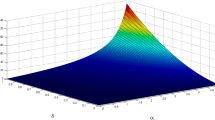Abstract
There are a lot of continuous evolving networks in real world, such as Internet, www network, etc. The evolving operation of these networks are not an equating interval of time by chance. In this paper, the author proposes a new mathematical model for the mechanism of continuous single preferential attachment on the scale free networks, and counts the distribution of degree using stochastic analysis. Namely, the author has established the random continuous model of the network evolution of which counting process determines the operating number, and has proved that this system self-organizes into scale-free structures with scaling exponent γ = 3+ α/m.
Similar content being viewed by others
References
A. L. Barabási and R. Albert, Emergence of scaling in random networks, Science, 1999, 28: 509–512.
S. H. Strogatz, Exploring complex networks, Nature, 2001, 410: 268–276.
B. A. Huberman and L. A. Adamic, Growth dynamics of the World-Wide Web, Nature, 1999, 401: 131.
R. Albert and A. L. Barabási, Statistical mechanics of complex networks, Rev. Mod. Phys., 1999, 74: 47–97.
R. Albert and A. L. Barabási, Topology of evolving networks: Local events and universality, Phys. Rev. Lett., 2000, 85: 5234–5237.
M. E. J. Newman, The structure and function of complex networks, http://www.arxiv.org/condmat/0303516v1, 25 Mar. 2003.
R. Albert and A. L. Brarbási, Statistical mechanics of complex networks, Rev. of Modern Phy., 2002, 74(1): 47–97.
B. Bollobas, O. Riordan, J. Spencer, et al., The degree sequence of a scale-free random graph process, Random Structures and Algorithms, 2001, 18(3): 279–290.
P. Erdös and A. Rényi, On the evolution of random graphs, Magyar Tud. Akad. Mat. Kutató Int. Közl, 1960(5): 17–61.
D. J. Watts and S. H. Strogatz, Collective dynamics of small-world networks, Nature, 1998, 393: 440.
S. Milgram, The small world problem, Psychology Today, 1967, 2(1): 61–67.
Z. M. Ma, The 3rd China Meeting on Complex Networks, Beijing, 2005.
G. L. Gong, Introductions of Stochastic Differential Equations, Press of Peking University, Beijing, 1995.
Author information
Authors and Affiliations
Corresponding author
Additional information
This research is supported by the National Natural Science Foundation of China under Grant No. 10671197.
This paper was recommended for publication by Editor Jinhu LÜ.
Rights and permissions
About this article
Cite this article
Geng, X. Random continuous model of scale-free networks. J Syst Sci Complex 24, 218–224 (2011). https://doi.org/10.1007/s11424-011-8076-6
Received:
Revised:
Published:
Issue Date:
DOI: https://doi.org/10.1007/s11424-011-8076-6



